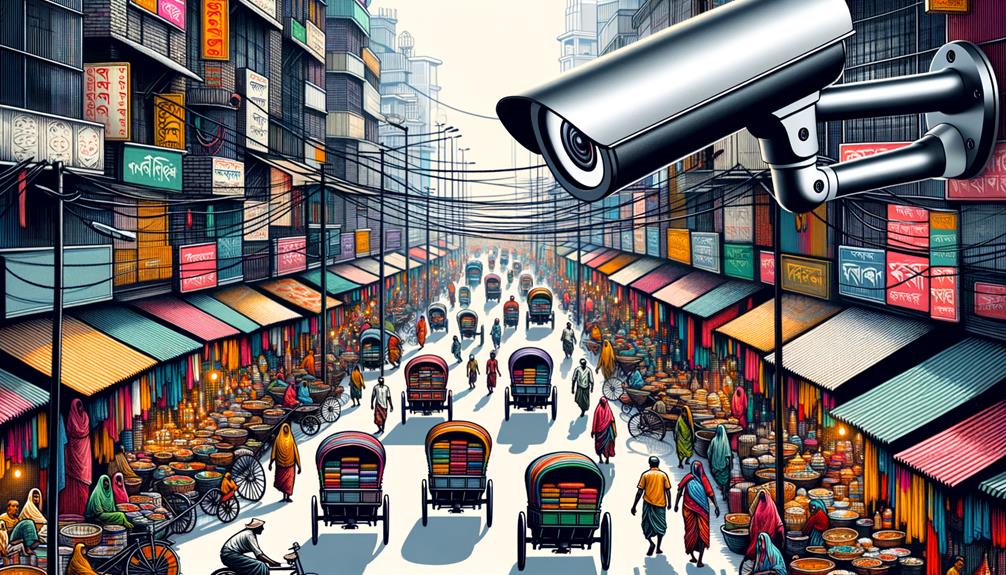Nestled in the northern region of Bangladesh, Nilphamari District is a captivating destination that beckons travelers with its rich history and natural beauty. From its origins as a hub for indigo cultivation during the British era to its transformation into a thriving district, Nilphamari has evolved into a place of cultural significance and vibrant communities. But it is not just its historical background that makes this district intriguing; it is also home to stunning natural attractions, such as the renowned Nilsagar. With its tranquil ambience and picturesque surroundings, Nilsagar has become a popular destination for those seeking solace in nature. As we embark on this journey to uncover the treasures of Nilphamari District, be prepared to be captivated by its intriguing past and awe-inspiring landscapes.
Etymology and Historical Background
The district of Nilphamari has a fascinating etymology and historical background that sheds light on its rich cultural heritage and agricultural significance. The historical significance of Nilphamari can be traced back to the British era when they established farms for cultivating indigo. The soil of Nilphamari was found to be fertile for indigo cultivation, leading to the construction of many nil kuthi and nil khamar (indigo houses). In fact, the term "nil khamari" is derived from "nil khamar". The word "Nilphamari" itself is derived from "Nil khamari". Initially, Nilphamari was under Rajshahi division but later became a subdivision in 1875 and a district in 1984. The district consists of six upazilas, four municipalities, 60 union parishads, 370 mouzas, and 378 villages. The extensive cultivation of indigo in the district played a significant role in its agricultural development. Additionally, Nilphamari became known for its railway workshop in Saidpur, which was established by the Assam-Bengal railway. The workshop in Saidpur became the largest in the Assam-Bengal District, and the telephone exchange for the entire district was also situated there. This highlights the historical significance and industrial development in Nilphamari.
Administration and Demographics
With the historical background and agricultural significance of Nilphamari in mind, the discussion now turns to the administration and demographics of this district.
- Administration:
- Nilphamari is divided into 6 upazilas, 4 municipalities, 60 union parishads, 370 mouzas, and 378 villages.
- The Deputy Commissioner of Nilphamari is Pankaj Ghosh, who oversees the district's administrative functions.
- Demographics:
- The population of Nilphamari district is [population number], with a population growth rate that has been steadily increasing over the years.
- The district has a moderate population density and a literacy rate of 49.69% according to the 2011 census.
- In terms of religious composition, Muslims make up 83.90% of the population, while Hindus account for 15.99%.
- Economic Development:
- Nilphamari district is primarily an agricultural region, with a significant portion of the population engaged in farming.
- The district's fertile soil and favorable climate contribute to its agricultural productivity.
- In recent years, efforts have been made to diversify the local economy and promote economic development in sectors such as small-scale industries, trade, and tourism.
Nilphamari district is not only known for its rich history and natural beauty but also for its administrative efficiency and evolving economy.
Nilsagar: A Historical Dighi
Nilsagar, a captivating historical dighi, is nestled in the picturesque Dhobadanga mauza of Gorgram union, approximately 14 kilometers southwest of the bustling district headquarters of Nilphamari. This enchanting body of water covers an area of 21.449 hectares and has a depth ranging from 7 to 12 meters. Nilsagar holds great significance for the local economy, attracting tourists and providing opportunities for birdwatching. The dighi serves as a popular tourist destination, drawing visitors from far and wide. The annual village fair held on the banks of Nilsagar, particularly during the Baruni Snan festival, adds vibrancy to the area. The fair is a celebration of culture, featuring Harikirtan singers performing traditional songs. Moreover, Nilsagar is renowned for its diverse bird population, including migratory birds. This makes it a paradise for bird enthusiasts and provides an economic boost to the local community through tourism. To evoke the beauty of Nilsagar, please refer to the table below:
Education in Nilphamari
Education plays a pivotal role in the development and progress of Nilphamari, enriching the lives of its residents and shaping the future of the district. The district has made significant strides in improving its education infrastructure and increasing literacy rates. Here are some key points about education in Nilphamari:
- The literacy rate of Nilphamari is currently 49.69% according to the 2011 Bangladesh census.
- The district boasts a well-developed education system with 940 primary schools, 295 high schools, and 95 colleges.
- It is also home to 1 medical college, 2 government and 17 non-government technical institutes, and 1 Primary Teachers Training Institute.
- To cater to the religious education needs of the community, there are 115 Dakhil Madrasas, 24 Alim Madrasas, 14 Fazil Madrasas, and one Kamil Madrasa.
- These educational institutions provide the residents of Nilphamari with the necessary knowledge and skills to contribute to the growth and prosperity of the district.
Transportation and Tourism
Nilphamari district is well-connected to various parts of Bangladesh through multiple modes of transportation, making it easily accessible for tourists and travelers alike. The district has a well-developed transportation infrastructure, with options including buses, trains, and air travel. Trains such as Nilsagar Express, Barendro Express, Titumir Express, Rupsha Express, and Simanto Express are available for those who prefer rail travel. Major bus services like Greenline, Nabil, Shyamoli, Hanif, S.A. Travels, and BRTC operate in Nilphamari, offering convenient transportation options. Additionally, the district has an airport located in Saidpur, which is approximately 20km from Nilphamari town. One of the popular tourist attractions in Nilphamari is Nilsagar, a historical dighi that attracts many visitors every year. The dighi's banks serve as a village fair site, especially during the Baruni Snan festival. Nilsagar is also known for its diverse bird population, making it a great spot for birdwatching enthusiasts.
Natural Beauty of Nilphamari
With its well-connected transportation infrastructure and popular tourist attractions like Nilsagar, Nilphamari district serves as a gateway to the natural beauty that awaits visitors. Nilphamari's scenic landscapes offer breathtaking views and a serene environment that is perfect for nature lovers. Here are some highlights of the district's natural beauty:
- Lush Green Fields: Nilphamari is known for its vast expanses of lush green fields, stretching as far as the eye can see. The vibrant greenery provides a stunning backdrop for visitors to enjoy and capture beautiful moments.
- Majestic Rivers: The district is blessed with several rivers that flow through its picturesque landscapes. These rivers not only add to the scenic beauty but also provide opportunities for boating and fishing activities.
- Diverse Wildlife: Exploring Nilphamari's wildlife diversity is a treat for nature enthusiasts. From colorful birds to exotic animals, the district is home to a wide range of species. Birdwatchers can spot migratory birds in Nilsagar, while wildlife lovers can encounter various animals in the surrounding forests.
Nilphamari's natural beauty is a hidden gem waiting to be discovered, offering a peaceful retreat from the hustle and bustle of city life.
Demographics and Resources
The district of Nilphamari in Bangladesh is home to a diverse population and abundant natural resources, making it a region of significant importance and potential for development. With a population of [population number], Nilphamari has a strong agricultural economy, with a significant portion of the population engaged in farming. The district's fertile soil and favorable climate contribute to the cultivation of crops such as rice, wheat, jute, and vegetables. The agricultural sector plays a crucial role in the local economy and provides livelihood opportunities for many residents. In addition to its agricultural resources, Nilphamari boasts a rich cultural heritage, with various historical sites and vibrant communities. The district is known for its cultural festivals and traditions, which showcase the unique customs and practices of the local people. These festivals, such as the Baruni Snan, attract visitors from all over the region and contribute to the district's tourism potential. Nilphamari offers a unique blend of natural beauty, a thriving agricultural economy, and a rich cultural heritage, making it a promising region for both economic and cultural development.
Cultural Heritage and Notable Personalities
Having explored the demographics and resources of Nilphamari district, it is now imperative to delve into its rich cultural heritage and the remarkable individuals who have made significant contributions to the region's development. Nilphamari boasts a diverse range of cultural contributions that have shaped its identity over the years. Notable landmarks and traditions, such as the historic Nilsagar dighi and the Baruni Snan festival, play a crucial role in preserving the district's heritage. Influential personalities from Nilphamari have excelled in various fields, including literature, art, music, and sports, leaving a lasting impact on the community. The district takes pride in its traditional arts and crafts, which reflect the cultural diversity of the region. The vibrant festivals and events celebrated in Nilphamari further showcase the district's commitment to preserving its cultural heritage. The fusion of different cultural elements has greatly influenced the district's unique identity, making Nilphamari a truly captivating destination.
Frequently Asked Questions
What Is the Main Mode of Transportation in Nilphamari District?
The main mode of transportation in Nilphamari District is a well-established network of buses, trains, and air travel. Buses connect Nilphamari to Dhaka and other major cities, while trains like Nilsagar Express provide convenient rail transportation. The district also has an airport in Saidpur, offering domestic flights. This efficient transportation system caters to the needs of the growing population and facilitates easy access to the district's rich history and natural beauty, making it an attractive destination for both locals and tourists.
Are There Any Famous Natural Landmarks in Nilphamari?
Nilphamari District is home to several famous natural landmarks that showcase its rich natural beauty. One of the notable landmarks is the Teesta Barrage, a magnificent structure built across the Teesta River. It not only serves as a source of irrigation and hydroelectric power but also offers breathtaking views of the surrounding landscape. Another popular landmark is the Singra National Park, known for its diverse wildlife and lush greenery. Visitors can explore the park's trails, spot rare species of birds and animals, and immerse themselves in the district's natural wonders.
How Many Primary Schools Are There in Nilphamari District?
There are a total of 940 primary schools in Nilphamari district. This indicates a strong emphasis on educational infrastructure and access to primary education for the local population. The district has a literacy rate of 49.69% according to the 2011 Bangladesh census. The presence of a significant number of primary schools highlights the commitment of the district to promote education and improve literacy rates among its residents.
What Is the Population Growth Rate in Nilphamari Over the Past Decade?
The population growth rate in Nilphamari over the past decade has been steadily increasing. With infrastructure development and improved living conditions, the district has attracted more people to settle down and contribute to its growth. The government's focus on education and healthcare has also played a significant role in attracting new residents. As a result, Nilphamari has witnessed a positive population growth rate, indicating the district's potential for further development and prosperity.
What Are the Major Industries or Economic Activities in Nilphamari District?
The major industries and economic activities in Nilphamari district include agriculture and textile. The district is known for its fertile soil, which allows for extensive cultivation of crops such as rice, wheat, jute, and tobacco. Agriculture plays a vital role in the local economy, providing employment and contributing to the district's overall growth. Additionally, the textile industry is also prominent, with several textile mills and factories operating in the area, producing a variety of fabrics and garments. These industries contribute significantly to the district's economic development and sustainability.





